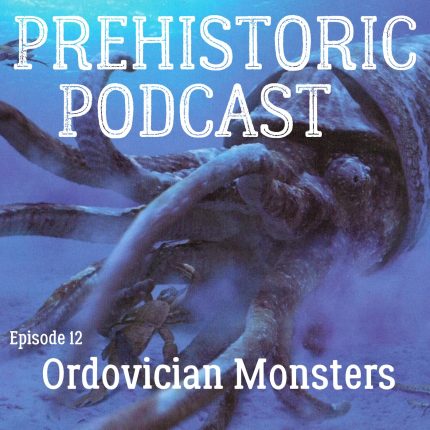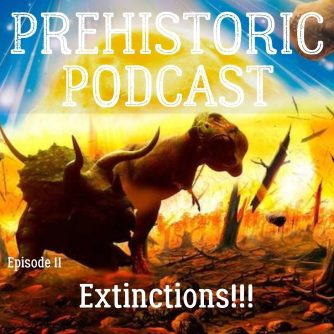Ordovician
- 488 M – 443 M Years ago (45 million years total)
- The great ordovician biodiversity event
- More complex organisms
- Land was one super continent Gondwana that migrated to the south pole during this time period
- CO2 in the atmosphere increased so the oceans were almost 2000 feet higher than they are today
- Squid like cephalopods (nautiloids) type creatures dominated the ocean.. some growing up to 20 feet long
- We saw the first jawless fish vertebrates with develop head armor
- Trilobites become very diverse… and they developed the ability to roll up in ball for protection
- Land was still dry barren at the beginning but plants started to expand to the land first.. arthropods starting moving towards more shallow lagoons
- They have found fossilized burrows of millipedes
- Climate change started an ice age and a huge drop in sea levels, reducing habitat. It’s also possible that the new plants on land were using up co2 which reduced greenhouse gasses.. helping the planet to cool
- Ordovician-silurian mass extinction event was the second worst extinction event. 85% of marine life died
Endoceras
Stethacanthus
Late – Devonian
Early Caboniferous
Two to three feet long and 10-20 pounds
1 Endoceras
Size:
Could have a 15 to 30 foot shell!. Giant nautiloid squid-like creature.
Largest cephalopod in the fossil record
Underwater killing machine:
Sported up to 10 arms with suckers and could jet through the water very fast.
It probably had an ink jet that it could use to confuse other predators and its bite was likely poisonous.
Some could be as small as your pinkie finger or as long as a telephone pole.
2 Megalograptus
Ancient sea scorpion. Did not have any venom in it’s tail. Was about 3 feet long and could swim very well.
They are related to horseshoe crabs
Covered in rigid armor and had sharp spines on it’s arms… they dominated until the evolution of jawed predator fish
Able to grow a new shell whenever needed like modern day crustations
Would have been soft and taken time to harden… so in order to have safety when they molted they would gather in huge herds and this is when they would mate and shed their shells.
The females could store the sperm in their bodies and then use it when they wanted to get pregnant.
Ambush predators that hunted fish and trilobites
They are believed to be among the first creatures to go onto land.
.
3 Aegirocassis
aye-gyro-casis
A member of a group of extinct animals called Radiodonts the same group as anonmalocaris
Radiodonts are early arthropods
7 feet long. Biggest radiodont ever
It was able to get so huge because it developed the ability to
It had fine hairlike spines hanging from it’s jaw. It was a “suspension feeder” .. it’s hanging comb like hairs filtered plankton from the water.
First of the giant suspension feeders
5 sacabambaspis – Saca bam bas pis
Extinct jawless fish .. about 10 inches in length
Sort of looked like a tadpole with an oversized head (watermelon with a tail)
Had a nice tail with a shark like fin
It had a head shield made of a large dorsal plate.. it’s armor was an evolutionary leap.. probably made.. made of material similar to human teeth
it inhabited coastal areas.. it was a bottom feeder and sucked in scraps of food through a mouth that never closed. It had sense organs that could feel movement in the water to help it find food and avoid getting eaten
9 arandaspis
Arandaspis prionotolepis is an extinct species of jawless fish. Discovered in australia. One of the earliest vertebrates. It had a streamlined body shape with a single fin on the back. It didn’t have any fins to stabilize it so it had to swim like a tadpole. It would move in short bursts. It also had a headshield made of thin bone. It had a lower and upper head shield with spaces for eyes and gills. It also had sense organs to sense predators.
It was a bottom feeder. About 6 inches
6 conodonts
- not well preserved but we think it’s a worm or eel like creature
- Only jaw mechanisms have been found
- Survived into the permian period
- They are used as an important tool in dating and figuring out which rocks belong to which periods by geologists.
- Super small.. only 200 microns to 5 millimeters
7 Asaphus
A type or trilobite. There were 35 different Asaphus species living mainly in europe
about 3 cm in length
Trilobites started to evolve eye stalks because selection pressure lead it to dig itself into the sea floor up to their eye. This was a way to avoid being eaten
Maclurites
Maclurites, extinct genus of Ordovician gastropods (snails)
Maclurites also had an operculum, or second shell, that covered the aperture of the larger body shell. Up to 15 centimeters. Maclurites was a relatively large gastropod, with a shell diameter up to 15 centimeters and a flat bottom that allowed it to remain stable on the ocean floor. One interesting specimen in the State Capitol (Figure 5) is closely associated in the stone with an operculum, a calcareaou “lid” that, in life, would have been attached to the animal’s foot and would have neatly sealed the shell opening when the foot was retracted.
Graptolites
Fossil graptolites are thin, often shiny, markings on rock surfaces that look like pencil marks, and their name comes from the Greek for ‘writing in the rocks’. They are the remains of intricate colonies, some of which accommodated up to 5000 individual animals; these individuals lived in a skeleton of collagen, similar to the material from which our fingernails are made.
Some graptolites lived on the bottom of the ocean, where they would stick to the surface with a special structure. They grew upwards, just like a plant, adding more living chambers as the colony got older. Other graptolites floated in the seawater, perhaps drifting with the ocean currents like seaweed.
The Graptolite polyparies vary considerably in size: the majority range from i in. to about 6 in. in length; few examples have been met with having a length of more than 30 in.
4 crinoids
Looks like a plant but it’s actually an animal. Same group of animals as sea stars and sea urchins
They are still alive today but are pretty rare
We have discovered about 700 living species of crinoids.. living ones can be referred to as “Sea Lillies” and there are some modern varieties that float free form in the ocean
It has Arms (tentacles), head (calyx) and stem (anchored to the sea floor)
They are fliter feeders and things floating by stick to their tentacles





